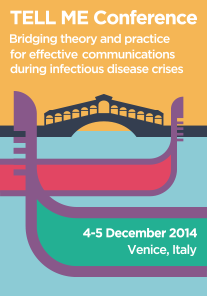What Ebola taught us about risk communication
 Each outbreak has some lessons to teach to those involved in health crisis management, especially in terms of risk communication. In fact, any infectious disease can become much more dangerous when supported by wrong or missing information. On the one hand, misinformation can spread far and fast, especially online, often crossing geographic borders before local organisations have ramped up their response to an outbreak. On the other hand, the lack of proper information about, for instance, how people get infected, may slow down efforts to contain the diffusion of the disease.
Each outbreak has some lessons to teach to those involved in health crisis management, especially in terms of risk communication. In fact, any infectious disease can become much more dangerous when supported by wrong or missing information. On the one hand, misinformation can spread far and fast, especially online, often crossing geographic borders before local organisations have ramped up their response to an outbreak. On the other hand, the lack of proper information about, for instance, how people get infected, may slow down efforts to contain the diffusion of the disease.
The Ebola outbreak that is currently raging in West Africa has highlighted these issues.
As of 26 August, this outbreak has already caused 3,069 infected cases with 1,552 deaths. So far, it has caused more cases and deaths than any previous Ebola virus disease (EVD) epidemic. Extreme poverty, dysfunctional health systems and fear are the three main reasons behind this international health crisis.
Of the four affected countries, three – Guinea, Liberia, and Sierra Leone – are among the poorest in the world, with large numbers of their inhabitants lacking salaried employment. In order to find work, large numbers of people flow back and forth through these countries’ borders, known to be porous and hard to control. Not surprisingly, the transmission of the virus has been consistent across the intersection of the three borders.
The health systems of the affected countries lack the necessary resources to tackle such an emergency: the capacity of local health facilities is not enough to host all the patients and the number of doctors available is particularly low, with the majority of them being concentrated in urban areas. Such a situation is aggravated by the fact that the virus infected more than 240 healthcare workers and more than 120 of them have died, including Sheik Umar Khan, the heroic doctor from Sierra Leone who was credited with treating more than 100 patients.
And here comes the fear factor.
Fear of being quarantined, which could drive infected people away from the surveillance system or push them to hide their sick relatives; fear of becoming infected by their own patients, which led healthcare professionals to refuse to go to work, thus depleting the already scarce health resources available; fear of not being able to provide for food, due to the block and the strict controls across the borders; fear of having been cursed, as, in some areas, Ebola is thought to be a product of witchcraft. Fear is nurtured by both misinformation and lack of information. This is the very reason why an effective risk communication may help to save lives.
TELL ME experts have been collecting and studying the existing evidence about risk and crisis communication during epidemics and pandemics. Their research suggests that risk communication requires a multi-layered approach that takes into consideration technological, cultural and social developments. On these bases, they developed a Framework Model aimed at local health organisations, which translates concepts and theories into a practical approach that can be adapted to specific risk situations and serve as the foundation for a communication guide. The model identified seven main components of risk communication and the inter-relationships between them: public sphere, segmentation, mass media, social media, opinion leaders, research and stakeholders.
Effective outbreak communication should be a dialogue between all these elements, with the public sphere very much at the centre. Most of all, TELL ME experts highlighted the importance of "listening to the public", in order to acknowledge that public fears should not be disregarded as irrational. On the contrary, they should be taken into account when planning an outbreak communication strategy, in order to build trust with the authorities and avoid the generation of misinformation from the onset of the outbreak.
Gaining people’s trust in West Africa, is not an easy task for authorities. Decades of war have fuelled the distrust of the population towards government and institutions, including healthcare ones. This, added to the already mentioned fear issue, constitutes a serious problem for one of the key relationship in health risk communication: the one between population and healthcare professionals. Acknowledging people’s concerns is thus crucial in order to establish a link between them and the institutions, a link that may become a channel to be used to fight both misinformation and the lack of proper information.
One way to build trust, as highlighted by TELL ME experts, is for the organizations to establish a presence on the media – especially on the social media – long before the emergence of a crisis. This would help to create a sense of community and to develop an interactive kind of communication, based on the exchange of information and opinions between individuals, groups and institutions. As mentioned before, “listening to the public” must be a core tenet when dealing with the public. A tenet that cannot be pursued if the risk communication is intended as a top-down message system, with the flow of information only moving one-way, from institutions to people. In such a system, there is no place for interactions and, as a consequence, there is no place for listening or acknowledging people’s concerns.
Health and government institutions of the affected African countries have not built a social media presence but this does not mean that it is too late for them to develop a two-way communication with the other stakeholders involved. This would mean not only the population, but also healthcare professionals. Appealing to them is crucial, not only because they are a mediating channel between health agencies and the public, but also because their higher exposition to a disease includes them amongst the risk groups. Which means that their risk perception could affect their risk analysis. Three members of the TELL ME consortium employed an online survey of Israeli health care professionals and the general public in Israel; they found that a relatively low risk perception from health care workers is associated with a tendency to base their behavior on analytical knowledge. However, if the risk perception is high, no significant difference was found between Israeli health professionals and the Israeli general public, meaning that they both base their attitudes more on emotions and personal experience than on analytical knowledge. This is another element that must be considered in health crisis management. In such a context, the impact of social media, both as a channel for misinformation or as a tool to tackle it, should be analysed carefully.
The dynamics behind the spread of false rumours have been recently investigated, using the riots occurred in Birmingham in August 2011, and the relative diffusion of misinformation on Twitter, as a model. This study revealed that false information, especially one with a dramatic content, might spread easily if not immediately challenged. However, as more people on Twitter found out about it, they began to cross-verify and check with official sources. This demonstrate that spontaneous reactions by social media users may counter the spread of misinformation online, even within hours, given that proper information are available for fact-checkers to use them.
In the Ebola case, many people in the regions struck by the virus started using social media in order to share information about the disease and its prevention. Hashtags like #EbolaFacts became trending topics, and were also shared by local celebrities. The high utilisation of mobile phones in West Africa strengthen the effect of these campaigns, thus allowing to offer proper information about how to avoid to become infected. However, the most rural areas in Guinea, Liberia, and Sierra Leone are not online, which means that those people most at risk of catching the virus are also those most difficult to reach.
There are other important issues to take into account: distrust towards the institutions due to long periods of conflict; superstition regarding both miracle cures or the supernatural origin of the disease; merits and flaws of social media as tools against wrong and missing information. These are some examples of social, cultural and technological elements that are characteristic of the West African situation and that will affect any approach to risk communication. These are elements that should be quickly identified when dealing with a health crisis.
This is the lesson we should learn by this Ebola outbreak. A lesson to be used to better fight this disease right now but also to better prepare for another one, because risk communication cannot simply be a reaction to a crisis but should help to be ready to face it before it occurs.
We have learnt from previous experiences that Ebola outbreaks can be contained, even without a vaccine or cure. Due to the virus’ features, identifying the infected persons, isolating them and treating them in proper facilities can break the chain of transmission, thus stopping further diffusion of the disease. And again, doing so requires a highly efficient communication strategy.
Michele Bellone
on behalf of TELL ME Consortium


